Bamyan is a province located in the central highlands of Afghanistan and is home to various bird species. From the majestic Griffin Vulture to the tiny Black-bellied Tit, Bamyan is a birdwatcher’s paradise.
There are many different types of birds, such as waterfowl, raptors, and songbirds, and these birds can be found in various habitats, such as rivers, mountains, and grasslands.
Birding in Bamyan is an exciting activity, as it offers the chance to witness a wide range of species in their natural environment.
The area is also known for its spectacular landscape, dominated by the ancient Buddhas of Bamyan, making birdwatching an even more fascinating experience.
23 Birds to Watch in Bamyan
Bamyan is a province in central Afghanistan, famous for its cultural heritage and natural beauty. But did you know that Bamyan is also a paradise for birdwatchers? The province is home to various bird species, some of which are rare or endangered.
Here are 23 birds you should look for if you visit Bamyan.
1. Greater Flamingo
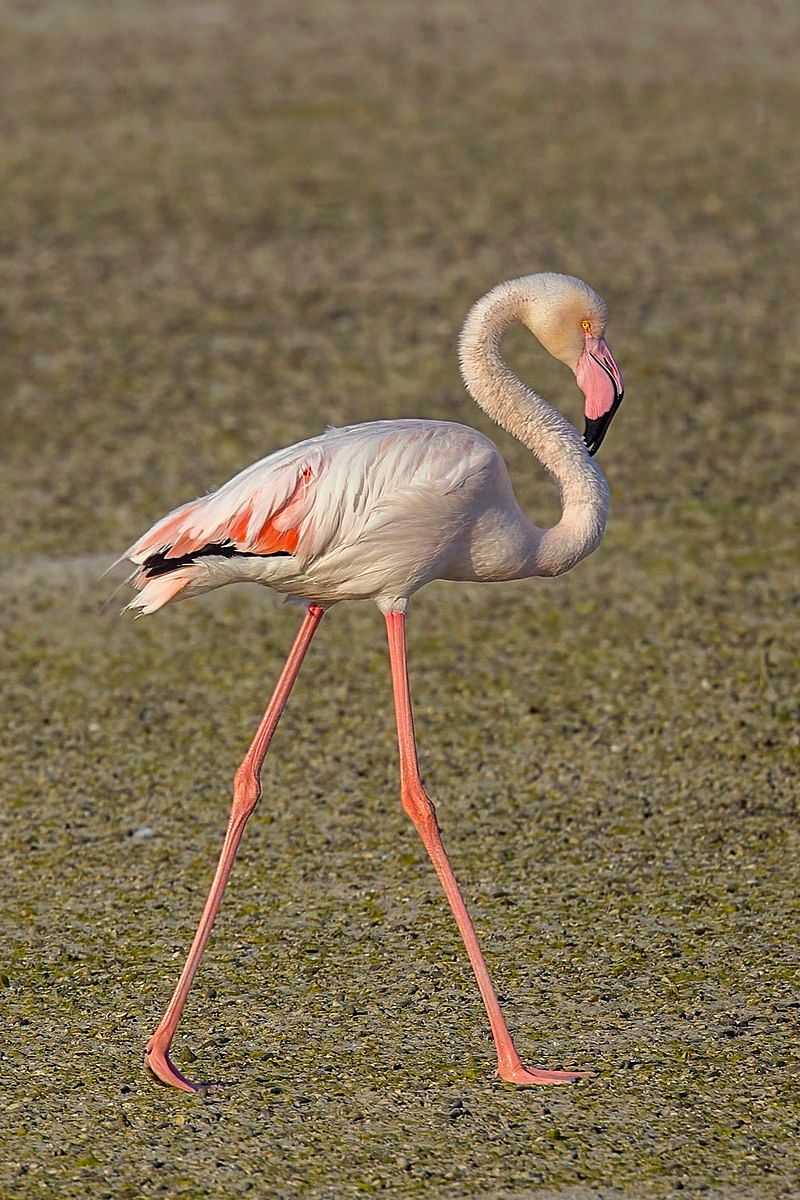
The greater flamingo is the largest species of the flamingo family and the most widespread species.
They are found in many parts of the world, including Northern and Sub-Saharan Africa, the Indian Subcontinent, the Middle East, the Levant, the Persian Gulf, the Gulf of Aden, the Red Sea, and the Mediterranean countries of Southern Europe.
These birds inhabit many habitats, such as salt and brackish lagoons, mudflats, and shallow coastal areas. They are usually found in large flocks and feed on tiny aquatic organisms, such as shrimp and algae.
Greater flamingos are highly social birds, forming strong bonds with one another. They also have a loud and distinct call, which they use to communicate.
In addition to being beautiful and impressive to watch, the greater flamingo is an integral part of the natural ecosystem, as it helps to keep water and soil clean by consuming a variety of aquatic organisms.
| Kingdom | Animalia |
| Phylum | Chordata |
| Class | Aves |
| Order | Phoenicopteriformes |
| Family | Phoenicopteridae |
| Genus | Phoenicopterus |
| Species | P. roseus |
2. Black Drongo
The black drongo is a small bird native to much of tropical southern Asia and Indonesia. It belongs to the Dicruridae family, which is a part of the passerine order of birds.
The drongo is a common resident breeder in these areas, ranging from southwest Iran through Pakistan, India, Bangladesh, Sri Lanka, southern China, and Indonesia. It is also an accidental visitor to Japan.
This species is typically found in open woodlands, scrub, and cultivation and is often seen perched on wires and other vantage points. The black drongo feeds on insects and is known to hunt by flying out from a perch to catch its prey in mid-air.
They also have a habit of following other animals to catch the insects stirred up by them.
| Kingdom | Animalia |
| Phylum | Chordata |
| Class | Aves |
| Order | Passeriformes |
| Family | Dicruridae |
| Genus | Dicrurus |
| Species | D. macrocercus |
3. Bulbuls
The bulbuls are a type of songbird belonging to the family Pycnonotidae. This family of medium-sized passerines is found across many parts of the world, from Africa and the Middle East to tropical Asia and Indonesia, and even as far as Japan.
The family includes several species of birds, such as greenbuls, brownbuls, leafloves, and bristlebills.
The Pycnonotidae family is quite diverse, with many members having distinct physical traits; for example, greenbuls tend to be small and have bright green plumage, while brownbuls have brown feathers and are slightly larger.
Leafloves are usually olive-colored, and bristlebills have a long, bristly bill and are generally gray. The habitat of the Pycnonotidae family is also quite varied. These birds can be found in forests, grasslands, and urban environments.
They are also quite adaptable and can live in various habitats, from tropical forests to deserts. The Pycnonotidae family is typical and can often be spotted in parks, gardens, and cities.
These birds are known for their beautiful songs and can often be heard throughout the day. They are also exceptionally social and can be seen in flocks or pairs.
| Kingdom | Animalia |
| Phylum | Chordata |
| Class | Aves |
| Order | Passeriformes |
| Family | Pycnonotidae |
4. Jacobin Cuckoo
The Jacobin cuckoo is a species of bird belonging to the cuckoo order, found in Africa and Asia. It is a partially migratory bird that migrates between different habitats at different times of the year.
In India, its arrival is associated with the monsoon rains, as it typically arrives ahead of the rains. This is why it has been considered a harbinger of the monsoon in India.
The Jacobin cuckoo is also known as the pied cuckoo or pied crested cuckoo due to the white patches of feathers on its neck and wings. It has a hefty bill and long tail, which helps it to travel long distances.
It typically feeds on insects, especially caterpillars, and is an integral part of the food chain.
| Kingdom | Animalia |
| Phylum | Chordata |
| Class | Aves |
| Order | Cuculiformes |
| Family | Cuculidae |
| Genus | Clamator |
| Species | C. jacobinus |
5. Black Bellied Plover
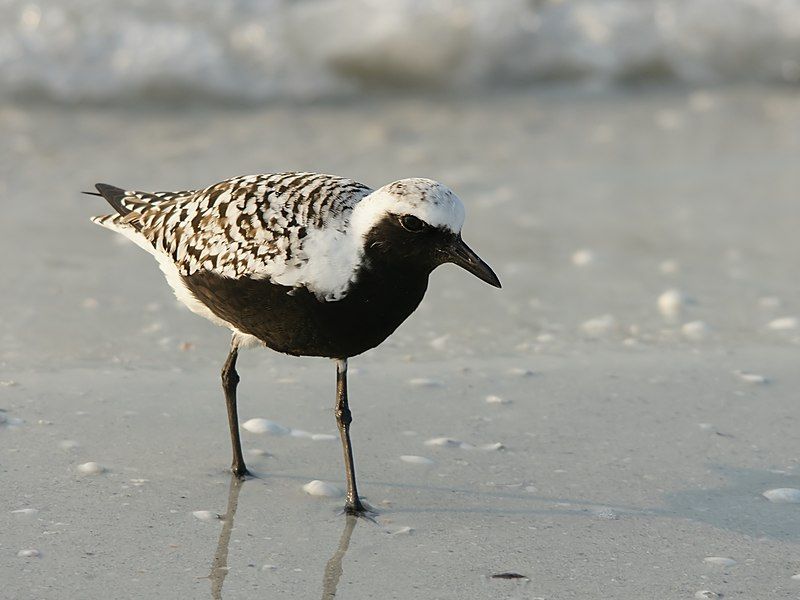
The Grey Plover, also known as the Black-Bellied Plover, is a species of bird that can be found across the globe. It is a large bird, usually found breeding in Arctic regions. It is a migratory species that moves from place to place depending on the season.
The Grey Plover can be found in coastal areas worldwide during the non-breeding season. This allows the bird to take advantage of the food sources available in different places.
The Grey Plover is a fascinating species of bird that has adapted to use the resources available worldwide.
| Kingdom | Animalia |
| Phylum | Chordata |
| Class | Aves |
| Order | Charadriiformes |
| Family | Charadriidae |
| Genus | Pluvialis |
| Species | P. squatarola |
6. Ruddy Shelduck
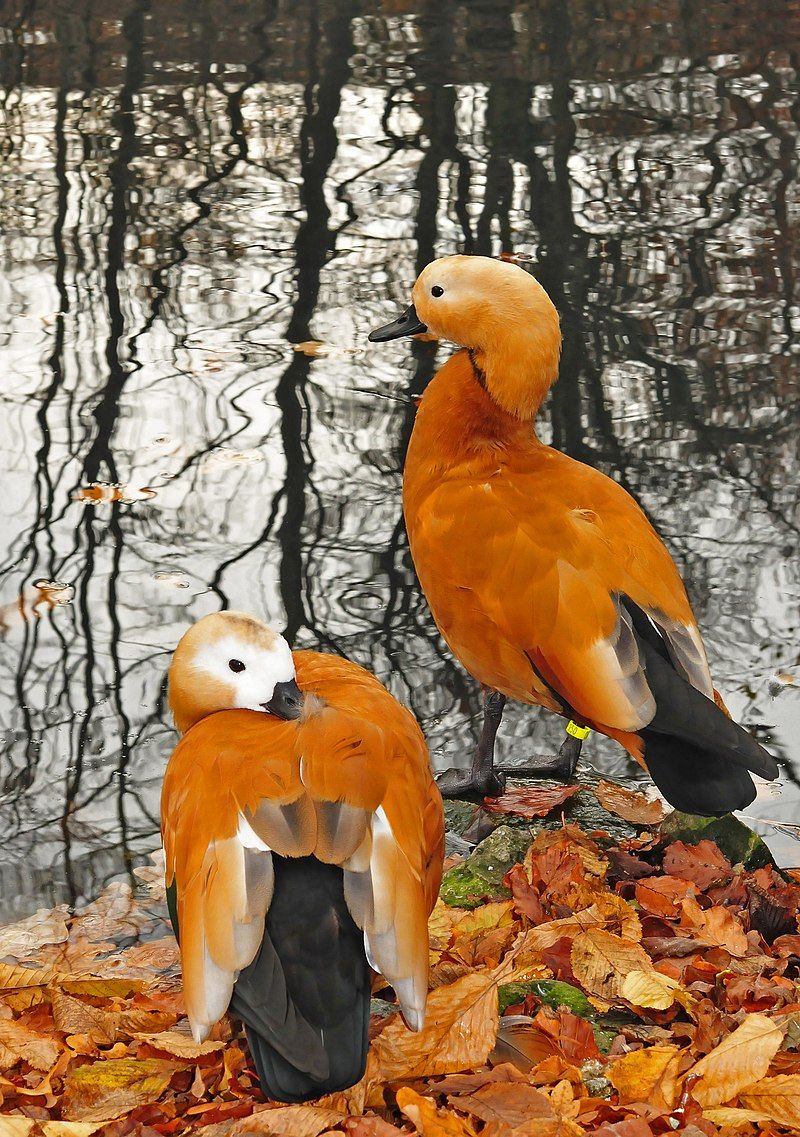
The ruddy shelduck, also known as the Brahminy duck, is a waterfowl native to India. It belongs to the family Anatidae, which also includes swans, geese, and ducks. This bird is easily recognizable due to its unique size and coloring.
It has a length of 58 to 70 cm and a 110 to 135 cm wingspan. Its body is reddish-brown, and its head and neck are black, with a white patch around its eyes. Its beak is a bright orange color with a black tip. Its legs and feet are also orange.
The ruddy shelduck is near wetlands like lakes, rivers, and marshes. It feeds on aquatic plants, insects, and small invertebrates. It is a reasonably social bird, living in large flocks and breeding in colonies.
| Kingdom | Animalia |
| Phylum | Chordata |
| Class | Aves |
| Order | Anseriformes |
| Family | Anatidae |
| Genus | Tadorna |
| Species | T. ferruginea |
7. Demoiselle Crane
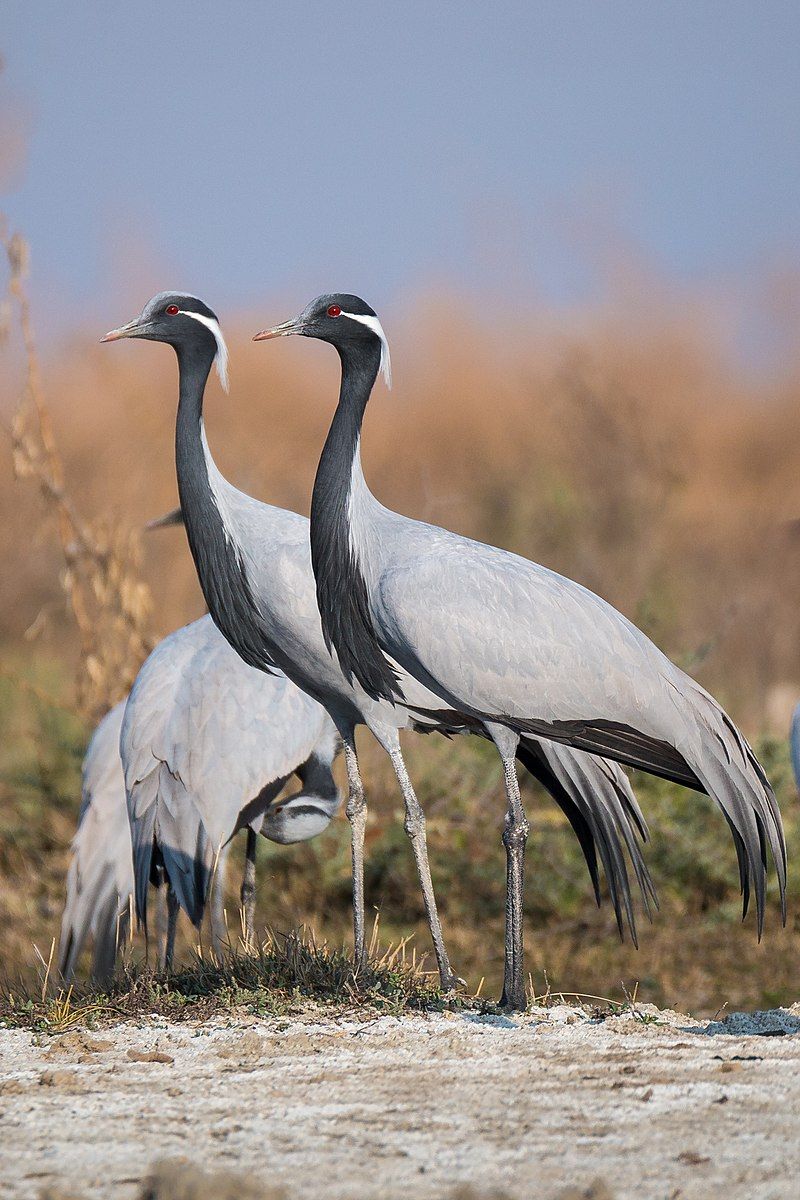
The demoiselle crane is an elegant species found in a large area of Central Eurosiberia. Its range spans from the Black Sea to Mongolia and Northeast China, with a small breeding population also present in Turkey.
These cranes are migratory birds, meaning they make regular journeys to travel from one area to another to breed or find food. During winter, they fly south from their breeding grounds in Eurosiberia to warmer climates and then return north in the spring.
The demoiselle crane is a fascinating species, and its annual migrations are a sight. Not only do these birds provide a spectacular display to birdwatchers, but they also play a vital role in the ecosystems they inhabit.
As they travel between different areas, they spread nutrients and help with the dispersal of seeds and other plant matter, aiding in the growth of vegetation and local habitats.
| Kingdom | Animalia |
| Phylum | Chordata |
| Class | Aves |
| Order | Gruiformes |
| Family | Gruidae |
| Genus | Grus |
| Species | G. virgo |
8. Great Bustard
The great bustard is a bird species in the bustard family, distinguished by its large size and unique genus, Otis. It is the only living species within this genus.
This species is known to inhabit open grasslands and farmland areas across a wide range of regions, from northern Morocco to Central and East Asia. The bustard is a migratory species capable of traveling great distances to reach its breeding grounds.
It tends to frequent temperate climates, such as those in Central and East Asia. During the breeding season, the bustard is found in areas of grasslands and farmland, where it can feed on insects, small mammals, and other forms of vegetation.
It is a shy bird, rarely seen in the wild, but its distinctive call can often be heard in the fields. The great bustard is an essential bird species, playing a vital role in the biodiversity of its natural habitat.
| Kingdom | Animalia |
| Phylum | Chordata |
| Class | Aves |
| Order | Otidiformes |
| Family | Otididae |
| Genus | Otis |
| Species | O. tarda |
9. White-throated Needletail
The white-throated needletail is a sizeable swift bird in the genus Hirundapus. It is well-known for its impressive size and speed. It is believed to be able to fly at speeds of up to 170 kilometers per hour in horizontal flight, although this has never been verified.
This is because the methods used to measure its speed have not been published, so there is no way to verify the accuracy of this claim. It is known by several other names, including needle-tailed swift and spine-tailed swift.
The white-throated needletail is found in many parts of the world, including India, Sri Lanka, Bangladesh, China, and the Philippines. It prefers to live in open woodlands and grasslands and is often found in large flocks.
It feeds on insects, spiders, and other small invertebrates that it catches while flying. Its wings are adapted to change direction rapidly, and its tail is forked, enabling it to maneuver quickly.
The white-throated needletail is a fantastic creature, and its impressive speed is something to behold. Unfortunately, without verifying the claim’s accuracy that it can reach speeds of up to 170 kilometers per hour, its remarkable speed remains a mystery.
| Kingdom | Animalia |
| Phylum | Chordata |
| Class | Aves |
| Clade | Strisores |
| Order | Apodiformes |
| Family | Apodidae |
| Genus | Hirundapus |
| Species | H. caudacutus |
10. Black-winged Stilt
The black-winged stilt is a species of wader, or shorebird, belonging to the avocet and stilt family. It is found in various habitats across many parts of the world, including wetlands, shallow lakes, and coastal lagoons.
It is characterized by its long, thin legs, which are usually black, and its black wings with white patches. Its scientific name, Himantopus himantopus, is also known as it. The black-winged stilt is an adaptable species, able to survive in various ecosystems.
It is found in Europe, Africa, Asia, and Australasia. It is a migratory species, traveling between breeding and non-breeding grounds.
It often nests in colonies on muddy, shallow wetlands during the breeding season. The black-winged stilt feeds on small invertebrates, such as insects, crustaceans, and small fish. It usually moves around quickly and can be seen in small flocks on the edges of wetland areas.
It is a social bird, often seen in groups on the ground or in the air. The black-winged stilt is a threatened species due to habitat destruction and human activities such as overgrazing, hunting, and pollution.
Conservation efforts are being made to protect the species and its habitats. Despite this, the species is still at risk due to its low population.
| Kingdom | Animalia |
| Phylum | Chordata |
| Class | Aves |
| Order | Charadriiformes |
| Family | Recurvirostridae |
| Genus | Himantopus |
| Species | H. himantopus |
11. Eurasian Oystercatcher
The Eurasian oystercatcher is a bird species belonging to the Haematopodidae family, part of the oystercatcher bird family. It is commonly referred to as the common pied oystercatcher, Palaearctic oystercatcher, or simply oystercatcher.
It is a wader, which means it is typically found near coastal areas or wetlands. The Eurasian oystercatcher is a large bird easily recognizable due to its black-and-white coloration. It has a long red beak and long pinkish-red legs.
The Eurasian oystercatcher is a highly social species often found in groups, particularly on the coast or in shallow waters. It feeds mainly on mollusks, particularly mussels and cockles. It also feeds on crustaceans, small fish, and even amphibians.
The Eurasian oystercatcher is an essential species for coastal wetlands and is a conservation concern in some parts of its range.
| Kingdom | Animalia |
| Phylum | Chordata |
| Class | Aves |
| Order | Charadriiformes |
| Family | Haematopodidae |
| Genus | Haematopus |
| Species | H. ostralegus |
12. Baikal Teal
The Baikal teal is a species of dabbling duck that inhabits a wide range of habitats across Eurasia. It is also known by two other names, the bimaculate duck and the squawk duck. The Baikal teal is native to eastern Russia and breeds during the summer months.
During the winter, the Baikal teal migrates to East Asia, where it can be found in various habitats, including wetlands, marshes, ponds, lakes, and rivers. The Baikal teal is a relatively small duck, measuring around 40 cm long and weighing around 500 g.
It has a distinctive black-and-white plumage, with a brown head, white breast, and black back.
The beak of the Baikal teal is short and yellow-orange, and the eyes are a deep red. The Baikal teal is an omnivorous feeder, eating plant matter and various small aquatic insects, crustaceans, and other invertebrates.
Its diet also consists of seeds, grains, and other vegetation. The Baikal teal is a highly social species, often gathering in large flocks to forage for food.
It is also known to be quite vocal, making loud, repetitive calls. The Baikal teal is listed as a minor Concern on the IUCN Red List due to its widespread distribution and stable population.
However, itfacesg some threats from habitat loss and hunting, and its numbers are decreasing in some areas. Conservation efforts are being made to ensure that the Baikal teal remains a common species in its range.
| Kingdom | Animalia |
| Phylum | Chordata |
| Class | Aves |
| Order | Anseriformes |
| Family | Anatidae |
| Genus | Sibirionetta |
| Species | S. formosa |
13. Common Shelduck
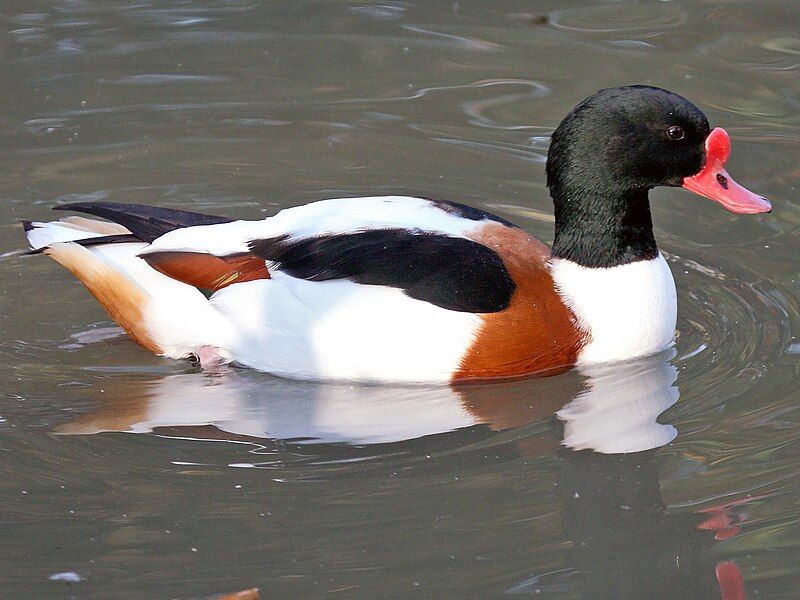
The common shelduck is a species of waterfowl belonging to the shelduck genus Tadorna. This species is widespread in the Euro-Siberian Palearctic region, an area extending from Europe and Asia to Siberia.
This species is commonly found in temperate climates and breeds there, but in winter, it migrates to subtropical climates. It is also known as winter in the Maghreb, which is a region in the northwest African continent.
The common shelduck is adaptable and can easily adjust to different environments. As a result, it can survive in a variety of climates.
| Kingdom | Animalia |
| Phylum | Chordata |
| Class | Aves |
| Order | Anseriformes |
| Family | Anatidae |
| Genus | Tadorna |
| Species | T. tadorna |
14. Ferruginous Duck
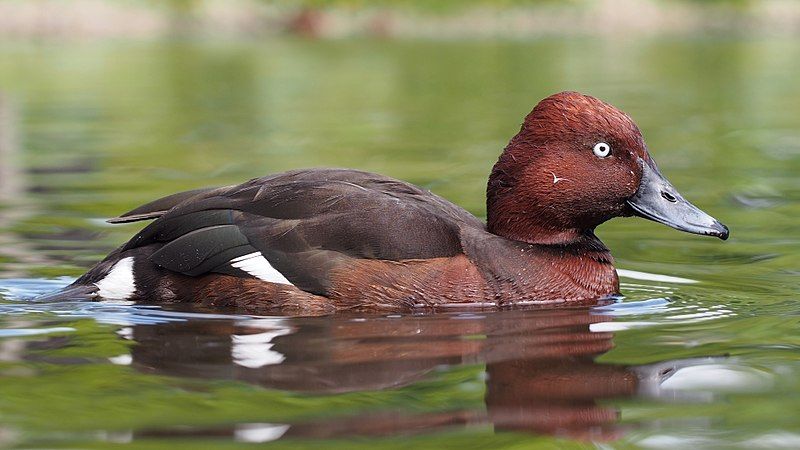
The ferruginous duck, also known as ferruginous pochard, common white-eye, or white-eyed pochard, is a medium-sized species in Eurasia. It is a diving duck, meaning it feeds underwater rather than foraging on the water’s surface.
The scientific name for this species is Aythya nyroca, derived from the Greek word Lithuania, which was used to refer to an unidentified seabird by authors such as Hesychius and Aristotle, and the Russian word nyrok, which translates to “duck.”
This species is a popular birdwatching target for birders due to its distinctive ferruginous plumage, rusty brown color, and unique habitat preferences.
They are found in shallow freshwater areas, such as marshes, lakes, ponds, coastal lagoons, and estuaries. These ducks are also known to migrate long distances, from the northern parts of Eurasia to the southern areas of the continent.
| Kingdom | Animalia |
| Phylum | Chordata |
| Class | Aves |
| Order | Anseriformes |
| Family | Anatidae |
| Genus | Aythya |
| Species | A. nyroca |
15. Garganey
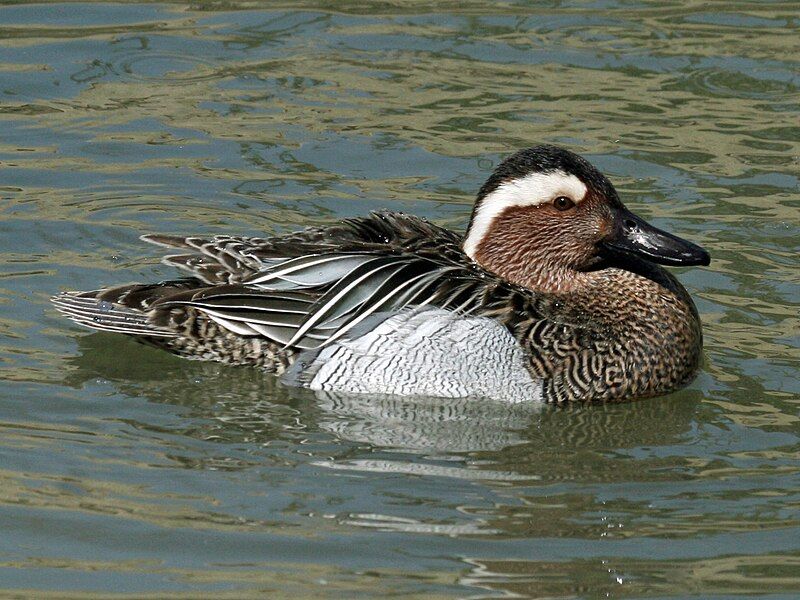
The garganey is a small dabbling duck found in much of Europe and the Palearctic region. It is a strictly migratory species, with the entire population migrating to southern Africa, India, Bangladesh, and Australasia during the winter of the Northern Hemisphere.
During this period, large flocks of garganeys can be seen in these regions, demonstrating the importance of migration for the species’ survival. The garganey is a small duck, typically measuring 16-18 inches long, with a wingspan of 24-28 inches.
It has a brownish-gray back, wings, white underside, and brown-tipped tail.
Males and females look very similar, with the male having a more colorful plumage. Garganeys feed mainly on aquatic invertebrates, such as insects, crustaceans, and mollusks, which they obtain by dabbling and upending in shallow waters.
They also feed on plant matter, such as seeds and grains. During winter, garganeys migrate to the warmer climates of southern Africa, India, Bangladesh, and Australasia.
Here, they can find the food and resources necessary for survival during the colder months.
Once the winter has passed and the days become warmer, the garganeys return to their breeding grounds in Europe and the Palearctic region.
By migrating, the garganeys can take advantage of the warmer areas’ milder temperatures and more abundant food sources, ensuring their survival even during the cold winter months.
This is an essential adaptation for a species that relies on aquatic invertebrates and plant matter, as these resources are more plentiful in warmer climates.
Not only does this ensure the species’ survival, but it also allows the garganeys to remain an essential part of their ecosystems.
| Kingdom | Animalia |
| Phylum | Chordata |
| Class | Aves |
| Order | Anseriformes |
| Family | Anatidae |
| Genus | Spatula |
| Species | S. querquedula |
16. Mute Swan
The mute swan is a species of waterfowl native to many parts of Eurosiberia and the northernmost reaches of Africa. It belongs to the family Anatidae, which includes other species of swan, geese, and ducks.
The mute swan is easily recognizable by its white plumage, long neck, and black bill. It has a graceful flight and is often seen gliding across calm bodies of water.
They feed mainly on aquatic plants, small fish, and insects and can often be seen preening their feathers and swimming in groups. They are a protected species in many parts of the world, and their populations have increased in recent years.
| Kingdom | Animalia |
| Phylum | Chordata |
| Class | Aves |
| Order | Anseriformes |
| Family | Anatidae |
| Genus | Cygnus |
| Species | C. olor |
17. Red-crested Pochard
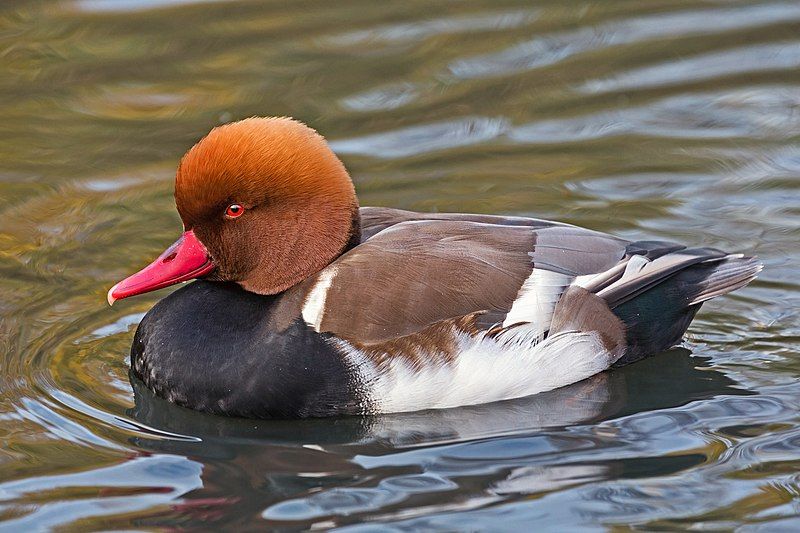
The red-crested pochard is a large diving duck native to Europe, Asia, and Africa. It is a widespread species for its distinctive red crest, which gives it its scientific name, Netta Rufina.
The genus name Netta comes from the Greek word meaning “duck,” and the species name Rufina comes from the Latin word meaning “golden-red.” This name refers to the duck’s crest’s color, typically a reddish-gold hue.
The red-crested pochard is an essential species for waterfowl hunters, as it is one of the few species of diving ducks that can be legally hunted. It is also a crucial species for conservation, as its population has declined due to habitat destruction and hunting.
The red-crested pochard is an essential species for both hunters and conservationists alike.
| Kingdom | Animalia |
| Phylum | Chordata |
| Class | Aves |
| Order | Anseriformes |
| Family | Anatidae |
| Genus | Netta |
| Species | N. rufina |
18. White-headed Duck
The white-headed duck is a small species of duck that is approximately 45 cm long in size. The male of the species has a distinctive white head with a black crown, a blue bill, and reddish-grey feathers.
On the other hand, the female of the species has a dark bill and a duller coloration. The white-headed duck is a species of diving duck, which means they dive to feed on aquatic plants and small animals found beneath the water’s surface.
They breed in lakes with open water and thick vegetation growing at the lake’s edge. The ducks use the dense vegetation as cover from predators and as a place to nest.
The white-headed duck is a unique species with distinctive features that stand out. It is also an important species as it is listed on the IUCN Red List as near threatened due to its decreasing population in some parts of the world.
Conservation efforts are underway to protect the species and ensure its future.
| Kingdom | Animalia |
| Phylum | Chordata |
| Class | Aves |
| Order | Anseriformes |
| Family | Anatidae |
| Genus | Oxyura |
| Species | O. leucocephala |
19. Bearded Reedling
The Bearded Reedling is a small songbird species found in reed beds worldwide. The species is sexually dimorphic, meaning males and females have physical differences, such as males having more brightly colored plumage.
It is commonly referred to as the Bearded Tit due to its similarity in appearance to the Long-tailed Tit or the Bearded Parrotbill. It is the only species in the family Panuridae, making it a unique species.
The Bearded Reedling is a small bird, typically measuring around 12 cm long. The male has distinctive black and white striped plumage on its head and chest, while the female has more muted colors of brown and grey.
The species has a short, square-tipped tail and a short, stubby bill. The birds feed mainly on insects, seeds, and small invertebrates. The Bearded Reedling is found in temperate and subtropical climates, usually near reedbeds, marshes, and wet meadows.
The species is a social bird, usually found in small groups or flocks. They are active during the day and can often be heard singing during the breeding season. The birds build their nests in the reeds, usually near water, and lay up to five eggs.
The Bearded Reedling is a unique bird species, not only due to its striking plumage but also because it is the only species in its family. It is a species of conservation concern in some parts of its range, and its numbers are declining due to habitat loss.
To ensure the long-term survival of this species, it is essential to protect and manage its habitats.
| Kingdom | Animalia |
| Phylum | Chordata |
| Class | Aves |
| Order | Passeriformes |
| Family | Panuridae |
| Genus | Panurus |
| Species | P. biarmicus |
20. Black Stork
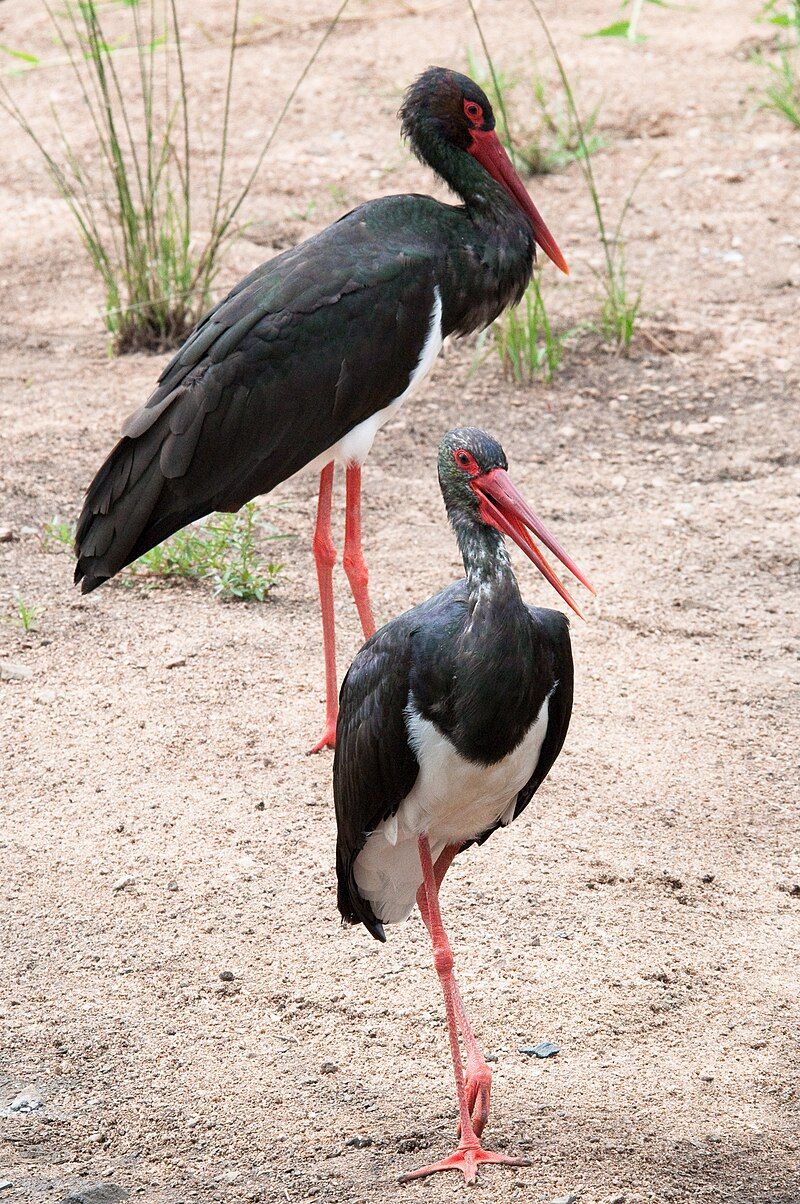
The black stork is a species of stork that belongs to the family Ciconiidae. Carl Linnaeus, a Swedish naturalist, was the first to formally describe the bird in the 10th edition of his Systema Naturae.
The black stork is a large bird with a length of around 85 cm and a wingspan of up to 2 m. It has black plumage, a white belly and rump, and a distinctive red bill. The eyes, legs, and feet are also red.
The species is found in parts of Europe, Africa, and Asia. It is a migratory bird, spending the summer months in the northern parts of its range and the winter months in the southern parts.
The species primarily feeds on fish and eats amphibians, reptiles, small mammals, and insects. The black stork is listed as vulnerable by the IUCN due to habitat loss and degradation.
Conservation and protection measures are in place to help the species recover, and its population is slowly increasing.
| Kingdom | Animalia |
| Phylum | Chordata |
| Class | Aves |
| Order | Ciconiiformes |
| Family | Ciconiidae |
| Genus | Ciconia |
| Species | C. nigra |
21. Blue-cheeked Bee-eater
The blue-cheeked bee-eater is a unique species of bird belonging to the Meropidae family, a type of passerine bird.
Its scientific name is Merops persicus, with Merops derived from the Ancient Greek meaning “bee-eater” and Persicus coming from the Latin word for “Persian.”
This species of bee-eater is known to inhabit the regions of North Africa and the Middle East, from eastern Turkey, Kazakhstan, and India.
They prefer open, dry habitats like semi-deserts, steppes, and savannahs. The blue-cheeked bee-eater is a social bird often seen in small groups or larger flocks.
They feed mainly on insects, particularly bees, and can be seen perching on branches or hovering in the air to catch their prey. The blue-cheeked bee-eater has a distinct visual appearance, with its bright blue cheeks, yellow and green body, and long tail feathers.
This attractive bird is a pleasure to watch in its natural environment.
| Kingdom | Animalia |
| Phylum | Chordata |
| Class | Aves |
| Order | Coraciiformes |
| Family | Meropidae |
| Genus | Merops |
| Species | M. persicus |
22. Common kingfisher
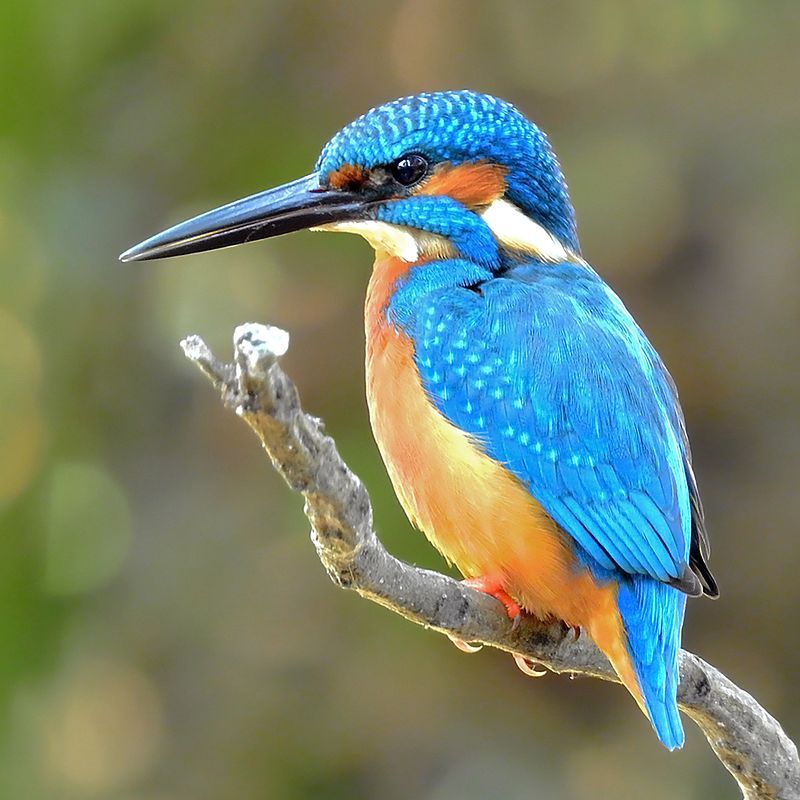
The common kingfisher, the Eurasian kingfisher and river kingfisher, is a small, vibrant bird with striking blue and orange plumage. It is found across Eurasia and North Africa; seven subspecies have been identified.
The common kingfisher is a resident species in many areas, meaning that it does not migrate elsewhere in search of food or to survive the winter months. However, it does migrate away from areas where rivers freeze over in winter, likely in search of a more temperate climate.
The common kingfisher is integral to many aquatic ecosystems, eating small fish and other marine animals and providing food for larger predators. It is also a famous bird to observe, as its colorful plumage and acrobatic flying skills make it a delightful sight.
| Kingdom | Animalia |
| Phylum | Chordata |
| Class | Aves |
| Order | Coraciiformes |
| Family | Alcedinidae |
| Genus | Alcedo |
| Species | A. atthis |
23. Indian Paradise Flycatcher
The Indian paradise flycatcher is a medium-sized passerine bird found in Asia. It is a widely distributed species in the Indian subcontinent, Central Asia, and Myanmar.
The global population of the Indian paradise flycatcher is considered stable, and as such, it has been listed as Least Concern on the IUCN Red List since 2004.
This means that the species is not under threat of extinction and that its population is stable. The Indian paradise flycatcher is a beautiful bird with a long tail and bright plumage.
It is an essential species in its native range, playing a vital role in the local ecosystems. It is an omnivorous bird, feeding insects, seeds, and small berries.
The bird’s breeding season usually occurs during the wet season, when food is more abundant. The Indian paradise flycatcher is a conservation concern, and efforts are being made to protect the species and its habitat.
This includes habitat protection and awareness campaigns to educate the public about the importance of preserving this species and its habitats.
Additionally, research is being conducted to understand better the species and its needs to develop effective conservation measures.
| Kingdom | Animalia |
| Phylum | Chordata |
| Class | Aves |
| Order | Passeriformes |
| Family | Monarchidae |
| Genus | Terpsiphone |
| Species | T. paradisi |
Conclusion
Birds are an essential part of the Bamyan ecosystem. They provide food, shelter, and nesting sites for many other species and help maintain the balance of the environment.
Furthermore, birds are an essential source of food for the people of Bamyan, providing them with a sustainable source of nutrition.
Through conservation efforts, we can ensure that the birds of Bamyan will continue to thrive and contribute to the environment’s health for generations to come.